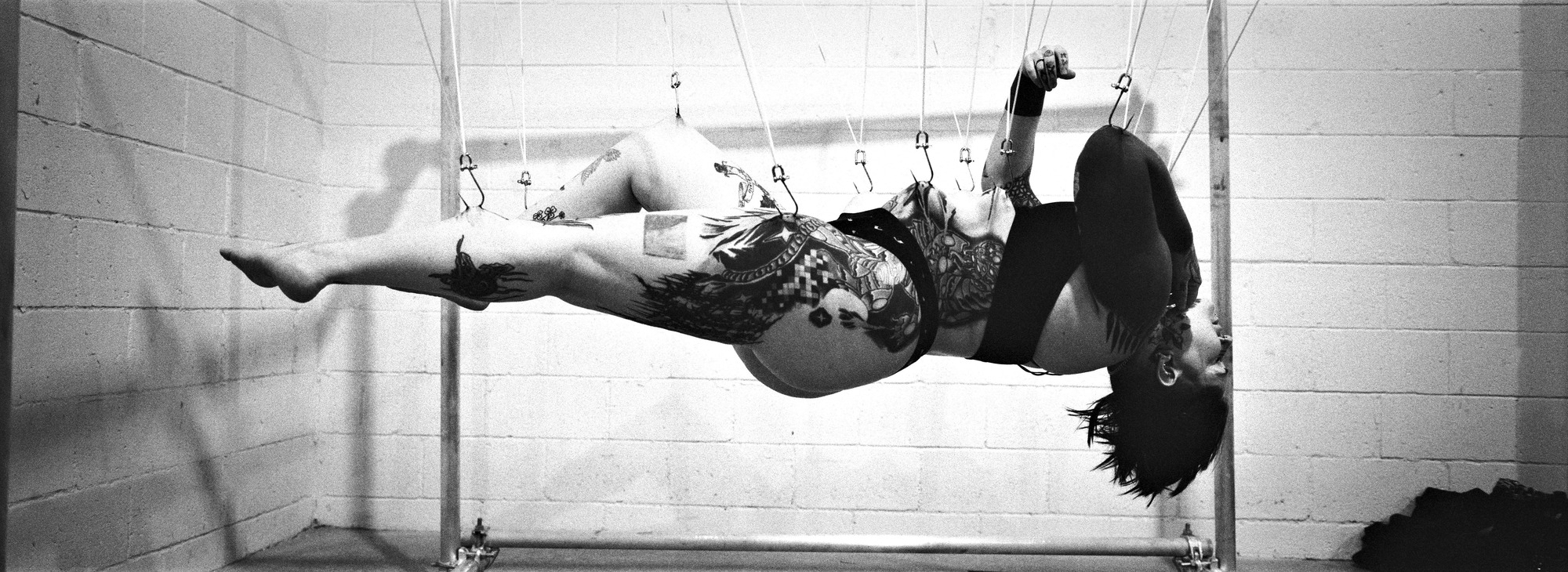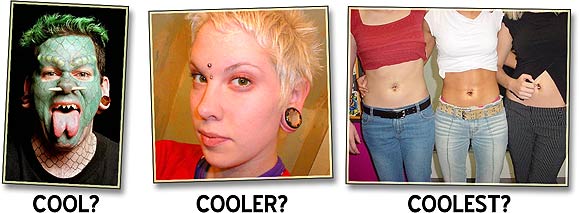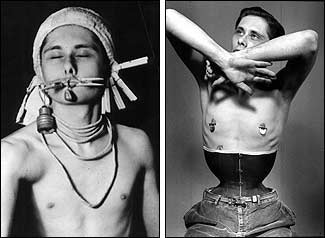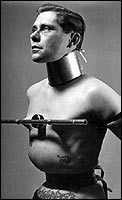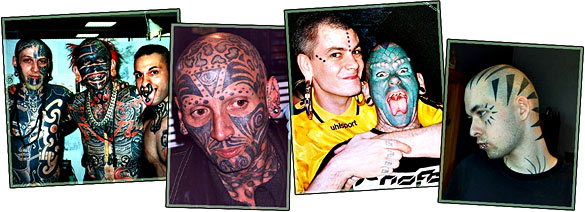
PART ONE |
Be daring, be different, be impractical, be anything that will assert integrity of purpose and imaginative vision against the play-it-safers, the creatures of the commonplace, the slaves of the ordinary.
– Sir Cecil Beaton
I get asked a lot of questions — in interviews, walking down the street, online, and so on. It is pretty much a near constant fact of daily life for me that someone will be asking me about something. And while a great deal of the questions are predictable and repetitive, I do catch my fair share from ‘somewhere out in left field.’
Earlier this month I decided to really open the floodgates as part of a new regular monthly feature for Through the Modified Looking Glass and asked IAM members to send me absolutely any question to which they would like to know my response. Hopefully you will find it as entertaining to read as it was for me to write. And now, the premiere edition of Lizardman Q & A!
deadinblood: They say there are two things humans know are going to happen to them in life; one being puberty, the other death [Editor’s note: I thought that was “death and taxes”?]. Most people are afraid of death — even to talk about it. Are you afraid of death?
I don’t think puberty is as certain as death — many die long before reaching it. And while it may not be as conscious a fear, I think people experience a great deal of fear and anxiety when approaching and experiencing puberty. As for the certainty of death, I know and have read a lot of immortalist literature and while I personally feel that there is a large amount of “pipe dreaming” in their thinking I do find many of their ideas to be inspiring — the most basic of which is that we should not simply accept death as inevitable. I do think though that it is very likely that I will die and that doesn’t scare me. I imagine that my death will be my final experience and thus I only hope I can make it magnificent.
stretched_thomas: What are your views on the “fat people disorder”? Why are we fat?
I think different fat people are fat for different reasons — but I think a great deal more of it can be traced to will (or lack thereof) than most would want to accept or find ‘politically correct’. For those having a hard time translating that: I think a lot of fat people are fat because they eat too damn much ‘bad’ food and exercise too damn little. I will accept alternate explanations on a case-by-case basis only when accompanied by a doctor’s note — which should detail not only your condition but also why you are so particularly bad at controlling it.
TheDiabolicSon: A friend of mine says robots going to replace human teachers in schools in the future. What do you think of that?
I think that in terms of effectiveness robots will not be able to do the work that humans can. In my experience good teaching includes a very connective, emotive, and, well, ‘human’ quality — but that doesn’t mean that this approach will not be tried. If such robots become cost effective (and possible) then expect them to be the norm — not unlike the babysitters that masquerade as teachers in many of our schools currently. I would personally never allow anyone I cared about to be solely machine educated.
CrazedInk: Has being part of acts such as the Jim Rose Circus Sideshow helped people watching your acts view the modified in better terms or has it been negative — that is, thinking that we’re all weird and freaks and belong in sideshows?
What’s wrong with the sideshow world? It is caring and supportive of its members and very fun and entertaining. As far as whether or not such shows contribute or detract from the general public’s respect for the modified… the answer is that it depends on the show and the viewer. A good performance demands and earns respect. I have known many people to have their first experiences of the modified be through such shows and those experiences were very positive when the show they saw was a good one. Of course, there are those who just always seems to react badly and I don’t think you can blame the shows — these are people that would have hated mods whether they saw them at a rock show or in an art gallery or anywhere else.
rat_xxx: Do people ever pull away their children when you go to the supermarket?
Very rarely. More often I get children who react in a positive and curious manner to my appearance who are then shuffled off by their parents out of embarrassment. Too bad really, since I will gladly play and talk with an inquisitive kid rather than have their parents stifle them like that.
Majik: I would like to know The Lizardman’s views on marijuana.
The history of legislation as relates to this plant is rife with politics that defy common sense — particularly in the use of hemp fiber and its many industrial applications (as pro-legalization people are often prone to point out, many of the founding fathers farmed hemp as a cash crop) that have no connection whatsoever with marijuana as a drug. As a drug I think it is no better or worse than any other and what comes of its use is far more a function of the user than the substance.
If you’re looking for an admission — yes, I have inhaled many times and enjoyed it. Overall, I can take it or leave it and current prevailing laws in the U.S. make it easier to leave it and avoid unnecessary hassles.
wldfire_1: If you ever have children do you worry what they will think? Or if it will make it hard for them to grow up with a father who looks like you?
I don’t plan on having any children but looking at it hypothetically I think that having me as a father, in terms of my appearance, would likely provide for both additional difficulties and privileges. It certainly wouldn’t deter me. I have other reasons for not wanting to be a parent.
Goat: What crazy stuff did you do when you were in college?
Why just while I was in college? Anyway, it’s more than I could possibly account for in anything less than a book — and that’s just the stuff I remember. Also, I’d have to check the statute of limitations on some things to make sure I wasn’t endangering myself.
Meghan: Over the course of our almost four years together, how much money have you spent on Cinnabons for me?
More than I should have, but I love you anyway.
Counterpunch: Do you feel the end of this planet is near? And when you first started modifying your body did you know that you would go as far as you have, and at what point did you decide to become the Lizardman? Have you ever got into a physical fight because of your appearance?
To answer your questions in order, no, but human life on this planet is always on the brink of ending in many possible ways.
I designed my transformation extensively before beginning it and before that I knew that if I were to undertake these sorts of modifications I would want nothing less than a full body concept. The idea and appearance of “Lizardman” really started to come together from ’93 to ’95 but I didn’t take that name per se until the end of 1998.
I have never fought anyone due to my appearance but I have defended myself — mostly in a pre-emptive fashion by ‘letting people know’ that they didn’t really want to fight with me. [Editor’s note: The Lizardman is an experienced martial arts expert in shito-ryu and shotokan-ryu karate, and definitely not someone you’d want to mess with!]
Numzy: Why a lizard? Why not a different animal?
I like lizards aesthetically and it was an obvious thematic amalgamation of all my procedures.
FREE: Boxers or briefs?
I am not a slave to underwear.
glider: As someone who’s now moving from personal friend of many people here (i.e. “on the same level”) to genuine “celebrity status”, how does that change your perception of the people you deal with every day, as well as your IAM page and personal blog in general?
I genuinely don’t think of myself as a celebrity. However, there are times when having that self-image is actually beneficial but I have to consciously work to maintain and project it.
I don’t think my perception of those I deal with every day has significantly changed — it is more a matter of an increased wariness towards new people. There is often a slight uneasiness about them attempting to use you or only wanting to attempt to profit from an association with you. But, I suspect that these sorts of people often greatly overestimate my value in this respect.
As for my public postings, I’ll admit to having edited myself a bit in entries in the past, but experience is showing me now that I tend to get a better response when I don’t tread so lightly.
obmf: What is the meaning of life? Also, all things equal (cost, upkeep, feeding, and so on), would you rather have a helper monkey, or a helper robot?
I am not at all convinced that life has a meaning and that the question isn’t simply an artifact of the defects of language. Meaning to me is primarily representative of part of the process by which we use symbols of various sorts to represent, and not a property of things. Also, searching for a meaning to life seems to very heavily imply that life is a more like a noun than a verb and my position would be the latter rather than the former.
As to your second question, I have to go with the robot — mainly for customization of appearance and design. If I so desired I could make it a robot monkey.
twitichingfetus: What is your stance on abortion?
I feel no more need or right to tell a woman what to do with her reproductive processes than I think anyone else should about how I cut my hair. Despite romanticized notions and expressions of couples being pregnant and the like, it is ultimately only that individual carrying the fetus that has any real claim to a decision regarding the pregnancy and then only that particular pregnancy. I certainly recognize that others will make claims beyond the individual based on moral and societal prerogatives but I find that I will almost universally deny the premises of those claims when presented.
And there you have it. If you have a question you would like to see me answer, watch my IAM page for the next time I request them. If I didn’t answer your question this time, feel free to re-send it then as well — it might have simply been a space or timing issue that kept it out. And finally, if I did answer your question but you didn’t like the answer — you can ask it again… I have been known to change my mind occasionally.

because the world NEEDS freaks… Former doctoral candidate and philosophy degree holder Erik Sprague, the Lizardman (iam), is known around the world for his amazing transformation from man to lizard as well as his modern sideshow performance art. Need I say more? Copyright © 2003 BMEzine.com LLC. Requests to republish must be confirmed in writing. For bibliographical purposes this article was first published July 23rd, 2003 by BMEzine.com LLC in Tweed, Ontario, Canada.
|

